For over 2,000 years of Buddhism in Vietnam, the famous name of Yen Tu Mountain has been associated with the name and career of Buddhist King Tran Nhan Tong who founded the Truc Lam Zen sect bearing the typical Buddhist culture of the Vietnamese people. This “sacred land” is the “capital” of Buddhism of Dai Viet (the old name of Vietnam). With the unique landscape, architecture, culture and history, Yen Tu Relic and Landscape Complex has been recognised as a special national relic and a dossier is being prepared to submit to UNESCO for its recognition of the complex as a World Heritage Site.
Visiting the Buddhist Sanctuary
On an early sunny day of May we made a pilgrimage to the Buddhist sanctuary on Yen Tu Mountain in Quang Ninh Province, where more than 700 years ago, King Tran Nhan Tong left his royal palace to lead an ascetic religious life and founded the Truc Lam Zen sect with a unique Buddhist culture of the Vietnamese people.
|
Yen Tu Relic and Landscape Complex consists of three groups:
- Yen Tu Historical Relic and Landscape Area (Uong Bi City, Quang Ninh Province)
- The Area of Historical Relics of the Tran Dynasty in Dong Trieu (Dong Trieu District, Quang Ninh
Province)
- The Western Yen Tu Relic and Landscape Area (Yen Dung, Luc Nam, Luc Ngan and Son Dong Districts, Bac Giang Province)
|
History says that King Tran Nhan Tong (1258 - 1308) who led the country to victory over the powerful Mongolian army of the Yuan Monarchy in two wars in 1285 and 1287 left his royal palace to go to Yen Tu Mountain to lead an ascetic religious life on a day in late 1299. This was an unprecedented event in the history of Buddhism in Vietnam. He founded the Truc Lam Zen sect and took the name Truc Lam Dai Dau Da. Later, people reverently called him “Buddhist King Tran Nhan Tong”.
Every year, from the 10th of January according to the lunar calendar and through three spring months, thousands of visitors from everywhere flock to Yen Tu Mountain to attend the Yen Tu Festival to commemorate Buddhist King Tran Nhan Tong, worship Buddha and contemplate the scenery in spring.
According to Venerable Thich Thanh Quyet, who is Head of the Management Board of the Buddhist Shangha in Quang Ninh Province and verger of Dong (Bronze) Pagoda on Yen Tu Mountain, in the initial days of leading a religious life, apart from practicing and studying the Buddhist tenets to disseminate Buddhist dharma, Buddhist King Tran Nhan Tong also ordered the construction of a system of religious architectural works comprising pagodas, temples and towers of special architectural and artistic value, such as Dong, Bi Thuong, Suoi Tam, Cam Thuc, Lan, Giai Oan, Hoa Yen, Mot Mai, Bao Sai and Van Tieu Pagodas, and Hue Quang and Hon Ngoc Tower Gardens.
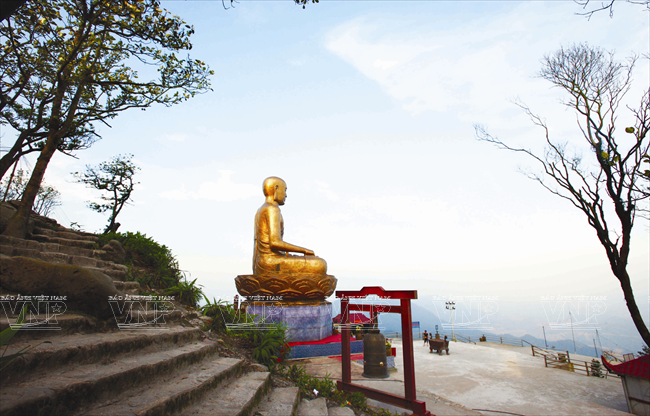 The statue of Buddhist King Tran Nhan Tong in a meditative pose, 138 tonnes in weight, is the largest copper statue in Vietnam.
The statue of Buddhist King Tran Nhan Tong in a meditative pose, 138 tonnes in weight, is the largest copper statue in Vietnam.  Dong Pagoda at the peak of Yen Tu Mountain, 1,068m above sea level, has been recognised as
Dong Pagoda at the peak of Yen Tu Mountain, 1,068m above sea level, has been recognised as
“a bronze pagoda on the highest mountain in Asia” by the Asian Record Organisation. Photo: VNP’s file
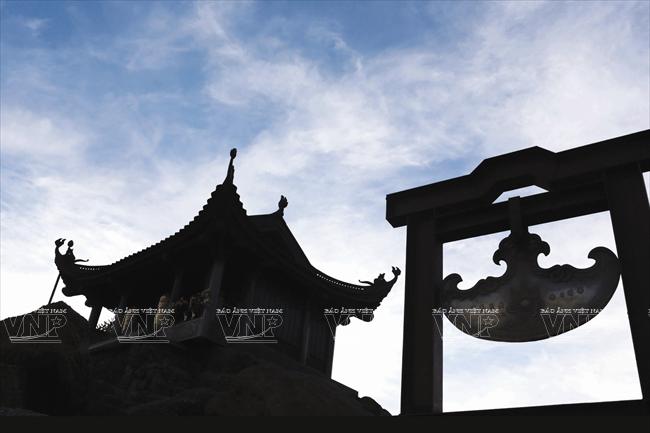 Dong (Bronze) Pagoda was built in the Post-Le Dynasty (the 15th century).
Dong (Bronze) Pagoda was built in the Post-Le Dynasty (the 15th century).
It was cast with pure copper and is 3m high, 12m2 wide and weighs 60tonnes. Photo: Hoang Ha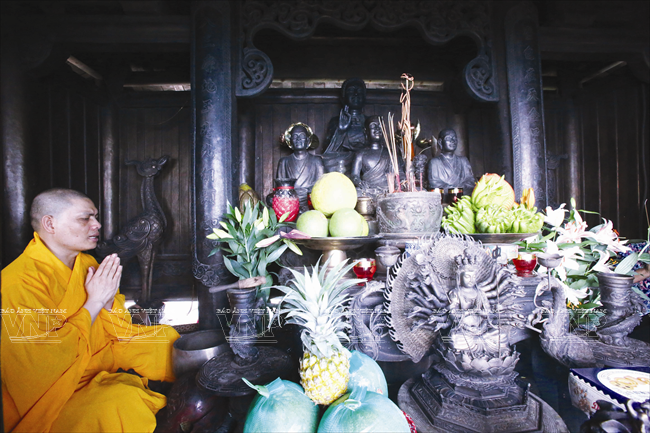 Reverend Thich Van Phong chairs a ceremony at Dong Pagoda. Photo: Hoang Ha
Reverend Thich Van Phong chairs a ceremony at Dong Pagoda. Photo: Hoang Ha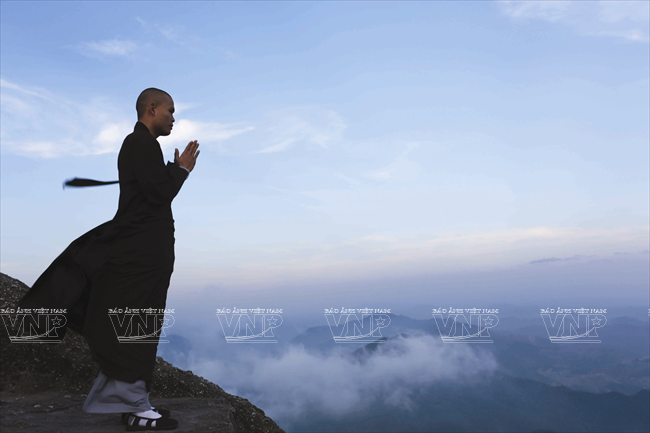 Reverend Thich Khai Thien, verger of Dong Pagoda on the peak of Yen Tu Mountain. Photo: Hoang Ha
Reverend Thich Khai Thien, verger of Dong Pagoda on the peak of Yen Tu Mountain. Photo: Hoang Ha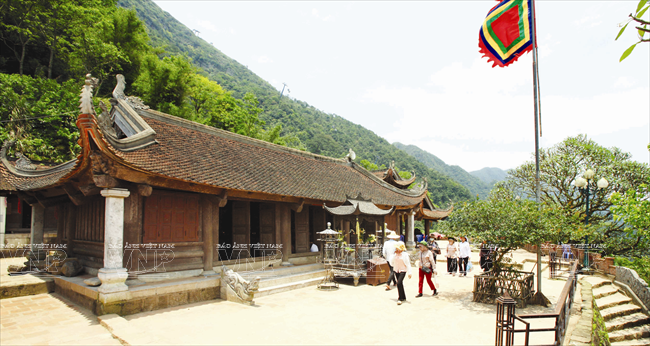 Hoa Yen Pagoda built in the Ly Dynasty (the 11th century) is the main one in the system of pagodas in Yen Tu. Photo: Trong Chinh
Hoa Yen Pagoda built in the Ly Dynasty (the 11th century) is the main one in the system of pagodas in Yen Tu. Photo: Trong Chinh
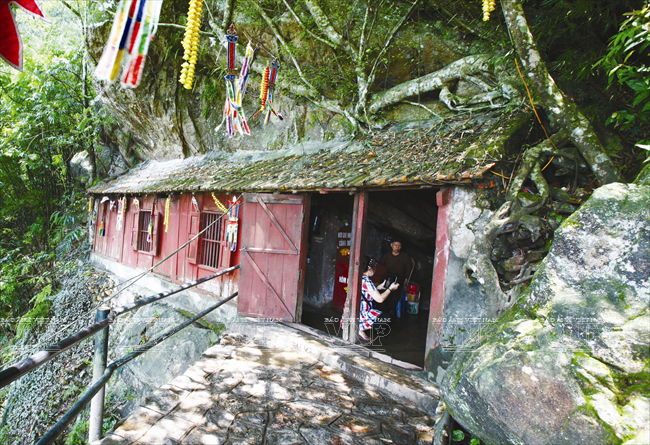 Mot Mai (one roof) Pagoda is located mid-mountain with its main roof half hidden in the mountain. Photo: Trong Chinh/
Mot Mai (one roof) Pagoda is located mid-mountain with its main roof half hidden in the mountain. Photo: Trong Chinh/
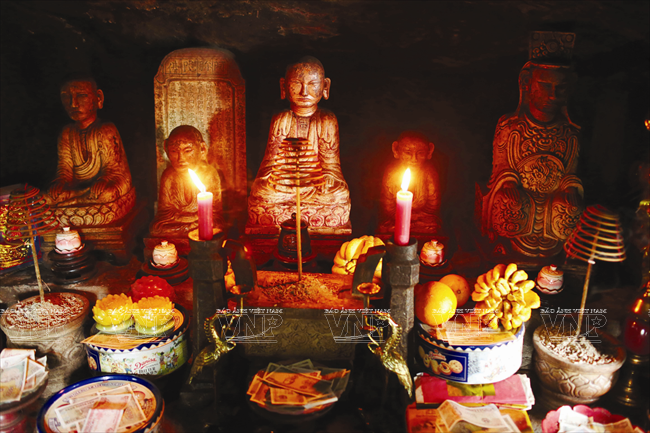
All the statues and worshiping objects in Mot Mai Pagoda were made from white stone
with an average size of 34-62cm and date back hundreds of years. Photo: Hoang Ha
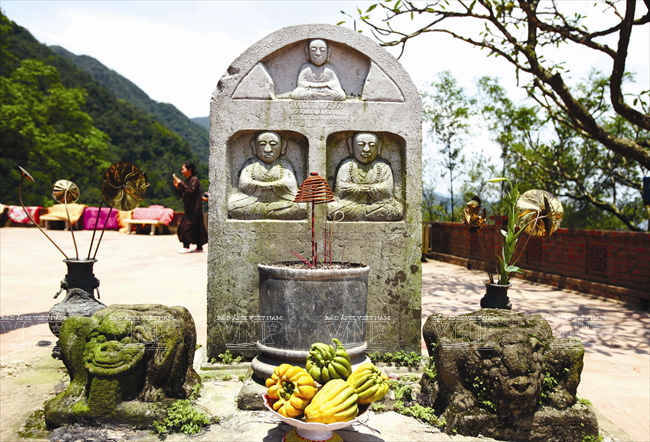 The vestige of an ancient pagoda of the Truc Lam Zen sect. Photo: Trong Chinh
The vestige of an ancient pagoda of the Truc Lam Zen sect. Photo: Trong Chinh Bohi tree leaf-shaped bricks and...
Bohi tree leaf-shaped bricks and...
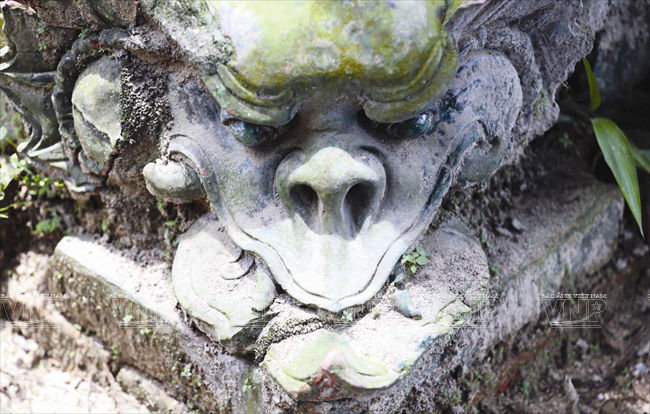
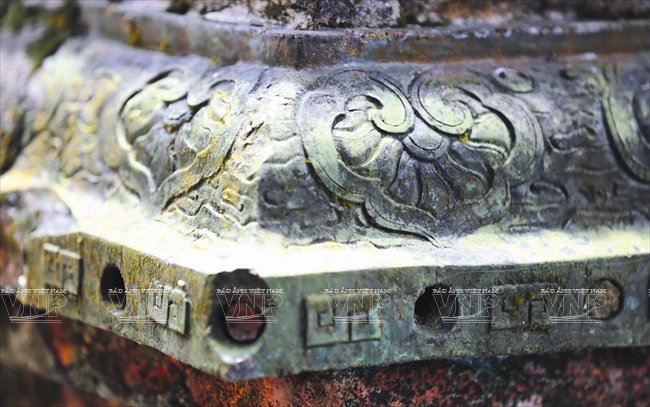 Patterns are imbued with imprints of the Truc Lam Zen sect in Thien Dinh Tower. Photo: Hoang Ha
Patterns are imbued with imprints of the Truc Lam Zen sect in Thien Dinh Tower. Photo: Hoang Ha
Over time and through the historical vicissitudes, Yen Tu still retains a gigantic treasure of Buddhist culture of the Vietnamese people from 700 years ago with dozens of pagodas, hundreds of temples and thousands of ancient precious relics which contain invaluable spiritual and ideological values of the Truc Lam Zen sect and the splendid culture of the Dai Viet (13
th – 15
th century).
The first destination of our pilgrimage was Giai Oan (Exoneration) Stream where legend has it that many imperial concubines and beauties committed suicide because they could not advise King Tran Nhan Tong to abandon his religious life to return to the palace. Feeling pity for them the king had a pagoda built to absolve them, thus the stream has the name Giai Oan.
We continued climbing up 500m higher, and then walking along a path shaded by green pine trees and reached Hue Quang Tower Garden. It is the place where a tower with the statue of Buddhist King Tran Nhan Tong inside is situated. The statue is 62cm high and made of marble, featuring a monk in a meditative pose.
Near Hue Quang Tower Garden is Hoa Yen Pagoda which was built during the Ly Dynasty (the 11th century). Above Hoa Yen Pagoda there are Bac and Vang Waterfalls with cool and pure water all year round. We went up on the stone steps and visited the pagodas with many traces which have been recorded in historical books. Finally, we reached the top of Yen Tu Mountain at a height of 1,068m above sea level where Dong Pagoda is. This is a unique and incomparable pagoda which has been recognised as “a bronze pagoda on the top of the biggest mountain in Asia” by the Asian Record Organisation.
Dong Pagoda was built in the Post-Le Dynasty (the 15
th century). It was cast with pure copper and is 3m high, 12m
2 wide and weighs 60 tonnes. It takes visitors 5-6 hours to go to Dong Pagoda by the fairly steep and rugged trail.
On the way, we came across monk Danh DaRa, verger of Sareyvonsa Pagoda in Dong Xoai Town, Binh Phuoc Province, who had just visited Dong Pagoda. He said: “Only reaching the top of the high mountain and seeing with my own eyes the place where the Buddhist King led a religious life in the old days can I perceive how noble and great his virtue, will and mind were.”
Evening shadow fell over Yen Tu Mountain. The sunset looked like a halo shining over the imposing statue of Buddhist King Tran Nhan Tong meditating in the grandiose space of the mountains. The scene with the breeze blowing through the forests, the sound of a wooden bell and the smell of incense made the visitors feel lost in the Buddhist world without selfishness, worry or sorrow. It is a common feeling for visitors to the mountainous area of Truc Lam – Yen Tu.
Reaching the Top of Phu Van Peak
Reaching the top of the sacred Yen Tu Mountain and walking slowly along the stone steps covered with moss, we and other pilgrims could not help being fascinated by the wild and superb beauty of the natural scenery around us.
«
The forests in Yen Tu have rich flora and fauna with 981 species. Here, 38 species of plants and 23 species of rare and precious endemic animals have been preserved. Typically, there are the vatica tonkinensis, erythrophleum fordii, chukrasia velutina, podocarpus, cinnamomum balansae, nageia, stephania, cortex acanthopanacis, morinda officinalis, and the snub-nosed langurs and flying squirrels.
»
|
Looking down from this altitude of 1,068m above sea level we saw a large northeastern area. Below, there is a very beautiful natural landscape of large mountains and vast forests looming amidst floating white clouds, which made us feel as if we were standing in a fairyland.
In the old days, Yen Tu Mountain was known by the name Bach Van Son because the top of the mountain was covered with white clouds all year round. It may be the reason why some people called it Phu Van (floating cloud) Peak.
The walkway from the foot of Yen Tu Mountain to the top is about 6,000m long and rugged. It takes visitors about six continuous hours to climb thousands of stone steps weaving through the wild forest to reach the top. On the two sides of the walkway, sometimes there are vast forests of green bamboo trees. These are a unique plant species of Yen Tu Mountain. With a straight trunk, bamboo symbolizes vitality and graceful, elegant beauty. It might be the reason that King Tran Nhan Tong chose this place to lead a religious life and named his Zen sect Truc Lam which means bamboo forest.
In addition to bamboo trees, Yen Tu also has a well-known road of pine trees. In a 200m-long section of the road, from Lo Ren temple there are more than 200 ancient pine trees nearly 700 years old. Legend has it that these trees were planted when King Tran Nhan Tong went to the mountain to lead a religious life. The trees are high and have solid branches with very green leaves.
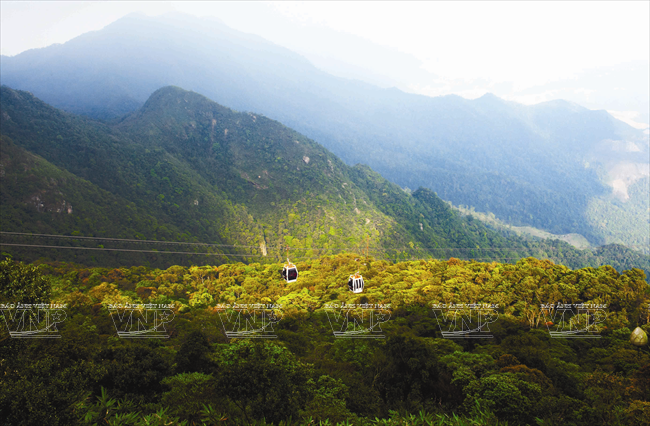
From cable cars, tourists can see the entire landscape of Yen Tu Mountain
with ancient pagodas, temples and towers lying in immense primitive forests.
On the sides of the walkway, sometimes there are vast forests of green bamboo trees which are a unique plant species of Yen Tu Mountain.
That might be the reason that King Tran Nhan Tong named his Zen sect Truc Lam which means bamboo forest. Photo: Trong Chinh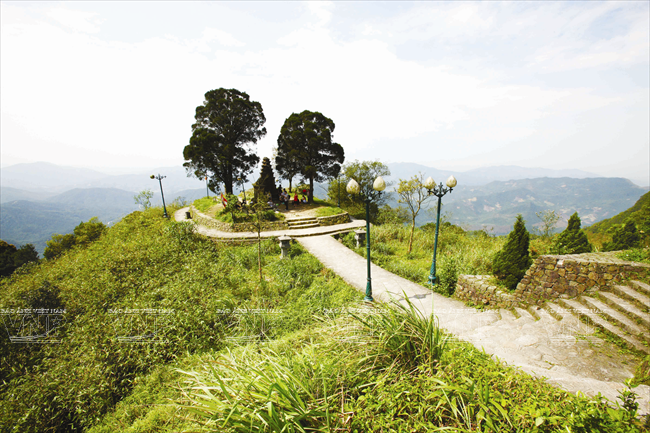
The tower garden in Van Tieu Pagoda and a system of religious architectural works,
such as pagodas, temples and towers in Yen Tu, has a special value in terms of architecture and art. Photo: Trong Chinh

Yen Tu has a well-known road of pine trees. Photo: Trong Chinh

From the 10th of January according to the lunar calendar and through three spring months,
thousands of visitors nationwide flock to Yen Tu Mountain to attend the Yen Tu Festival
to commemorate Buddhist King Tran Nhan Tong, worship Buddha and contemplate the scenery in spring. Photo: Trang Linh
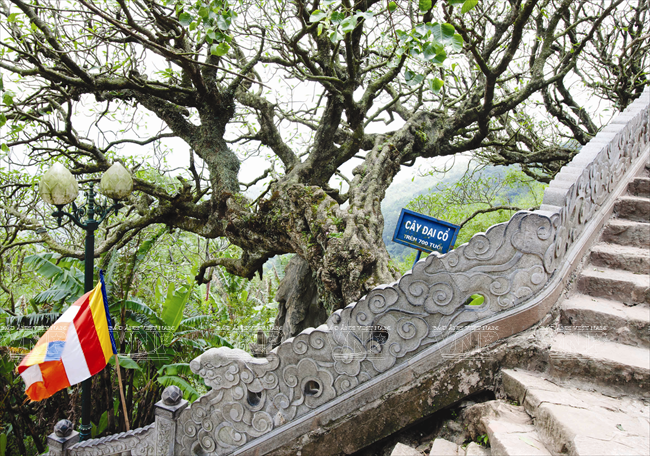 One of the 700 year old trees in Hoa Yen Pagoda grown by the third ancestor of Truc Lam Zen sect. Photo: Trong Chinh
One of the 700 year old trees in Hoa Yen Pagoda grown by the third ancestor of Truc Lam Zen sect. Photo: Trong Chinh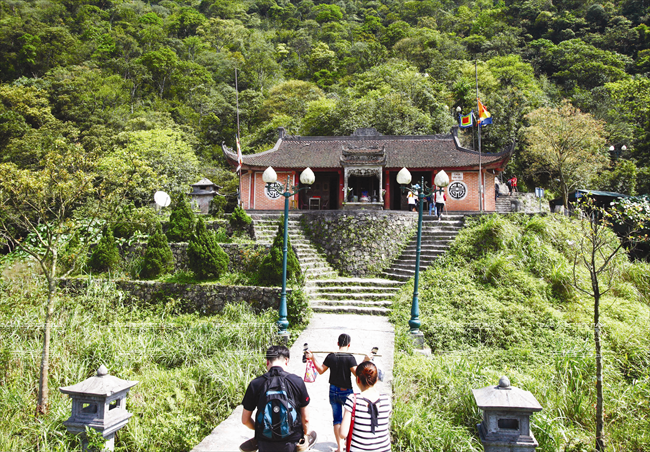 Van Tieu Pagoda is located about 700m above sea level. Photo: Trong Chinh
Van Tieu Pagoda is located about 700m above sea level. Photo: Trong Chinh
Yen Tu is a high mountain range lying in the northeast of Vietnam. It was formed in the Quaternary and has various types of original stones, such as sandstone, gravel and ancient alluvia. The complicated topography and geology in this area has created many beautiful natural landscapes, such as Ngu Doi, Vang and Bac Waterfalls, heaven’s gate, the road of pines trees, forests of bamboo trees and Yen Tu Mountain.
In 2011, the Prime Minister issued a decision to establish Yen Tu National Forest. Covering an area of nearly 2,800ha, Yen Tu National Forest is not large but it is associated with Yen Tu Special National Relic. It preserves many genetic sources of rare and precious plants and animals which no other places have, especially the precious species like yew (white wood), shimpaku (green wood), red pine, bamboo, yellow apricot and many rare medicinal plants, such as codonopsis, aloes wood, stephania, fibraurea recisa, codonopsis pilosula, cibotium barometz and smilax glabra.
Nguyen Trung Hai, Head of the Management Board of Yen Tu Relics and National Forest said that the management board was implementing a project on zoning off the areas to grow, protect and conserve the forests strictly to protect the resources of rare and precious plants and animals and preserve the genetic sources for scientific research purposes.
In the past decade, nearly 1,000 billion dong was invested in the restoration of the relics and construction of the technical infrastructure in Yen Tu, including the cable car system with a nice design in harmony with the surrounding landscape and environment to serve tourists.
From this system, visitors can see the entire landscape of Yen Tu Mountain with ancient pagodas, temples and towers lying in the pine and bamboo forests and green primeval forests on the wild and grandiose mountains. They can enjoy nature with a sacred atmosphere of a peaceful and pure Buddhist world.
Story: Thanh Hoa - Photos: Trang Linh, Trong Chinh, Hoang Ha & VNP’s File